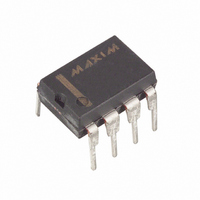DS1866 Maxim Integrated Products, DS1866 Datasheet

DS1866
Specifications of DS1866
Available stocks
Related parts for DS1866
DS1866 Summary of contents
Page 1
... The DS1866 is available as a 10k potentiometer and is available in an industrial temperature grade. Additionally, the DS1866 will operate from supplies and is ideal for portable applications requiring low standby current. Two packaging options are available and include the 8-pin (300-mil) DIP, 8-pin (150-mil) SOIC. ...
Page 2
... W-terminal whose position is controlled via a 3-terminal parallel port consisting of input signals P0, P1, and P2. A block diagram of the DS1866 is shown in Figure 1. Wiper position setting of the DS1866 is determined by the states of the P0, P1, and P2 input terminals. Table 1 below outlines position setting versus value of the parallel port inputs. A Position-0 setting places the wiper position at the L-terminal of the potentiometer and provides attenuation ...
Page 3
... One Time Programmability (OTP). The DS1866 can be easily used as an OTP device. This can be accomplished by terminating the P0, P1 desired logic levels during system manufacturing. On power up, the value of P0, P1, and P2 will then set the wiper position setting of the DS1866. DS1866 BLOCK DIAGRAM Figure 1 ...
Page 4
... GND +0 2.7V to 5.5V) CC MAX UNITS NOTES 400 µA +1 µA 1000 1 mA µA 50 µA = 2.7V to 5.5V) CC MAX UNITS NOTES +20 % +1.0 dB +1.0 dB MHz ppm/°C (25° 2.7V to 5.5V) CC MAX UNITS NOTES 2.7V to 5.5V) CC MAX UNITS NOTES 500 ns 102199 DS1866 ...
Page 5
... However, this change will not exceed ±20% of the nominal resistor value of the part. 8. Absolute tolerance is used to compare measured wiper voltage versus expected wiper voltage as determined by wiper position. The DS1866 is specified to provide an absolute tolerance of ±1.0 dB. 9. Tap-to-tap tolerance is used to determine the change in voltage between successive tap positions. The DS1866 is specified to provide a tap-to-tap tolerance specification of ± ...






